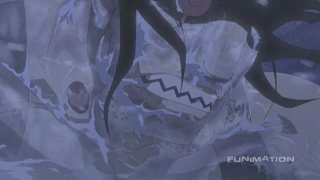Ani-Gamers staff writer Ink contributes a weekly column in which he examines the differences between the original Fullmetal Alchemist and its re-telling, Fullmetal Alchemist: Brotherhood. To read previous entries, click here.
Watch Episode 35 – The Shape of This Country
One of the most startling developments in FMA1 for me was the sucker-punch one of the few last episodes threw at its viewers guts by explaining the origin of the energy behind alchemy: human deaths in the parallel world we call home (or at least so did our relatives who lived in pre-WWII times). This was interesting because it meant Ed was unwittingly using the dead throughout his entire life all while he was opposed to killing/sacrificing people for the creation of the philosopher’s stone.
FMA2 is beginning to touch upon that but in a rather brilliant if not more subtle approach, and it leverages the different approaches to alchemy and alkahestry from Armestris and Xing, respectively. As Marcoh and Shao May look over Scar’s brother’s research notes, Marcoh expresses frustration at Alkahestry’s notion and use of the “Dragon Pulse,” which is then explained as chi by Shao May and fits into FMA1’s “All is one, one is all” lesson from teacher (Izumi) rather nicely. But Marcoh explains that alchemy uses the energy of the movement of the earth’s crust as its energy source.
These ideas are very similar to each other (differing only in connectivity and mechanics) and very different from FMA1, not only in source but honesty as well. FMA2 openly acknowledges equivalent exchange is not all there is to alchemy, bypassing one of FMA1’s more arduous drinking games: “take a shot every time they reference equivalent exchange.” And the subtlety I mentioned before? It comes in a wonderful bit of writing that gently questions the aforementioned difference between FMA 1 and 2. After Marcoh explains the notions behind Armestrian alchemy, Shao May says that she has felt something odd ever since arriving in Armestris, mainly that the “energy flowing under [her] feet doesn’t feel like the energy of the Earth’s crust in motion, but more like a lot of people squirming around.” A very nicely executed hint that Armestrian alchemists have been using people’s life energy all along for their alchemy, or just an allusion to FMA1? Either way, it was a brilliant and not overstated nod to the possibility.
Another interesting contrast is the hindered manner in which Mustang is forced to garner support for his coup, which was shown in episode 32, and is now paralleled by Ed’s search for help in Briggs. Let alone the fact that FMA1’s Ed was never concerned with toppling the government, instead committed to stopping the homunculus plot, but now he’s fully involved with both, as FMA2 has managed to combine them into a inseparable chimera of plot. Add to all of this the covert way in which Ed and Mustang both have to sneak about to assess who is an ally, and the differences between FMA1/2 are plain as day. No longer do we have rogue Ed/Al and scheming Mustang, now we have Ed becoming Mustang, fully realizing the chains Armestrian alchemists wear around their necks as leashes held in the Fuhrer’s whim.

